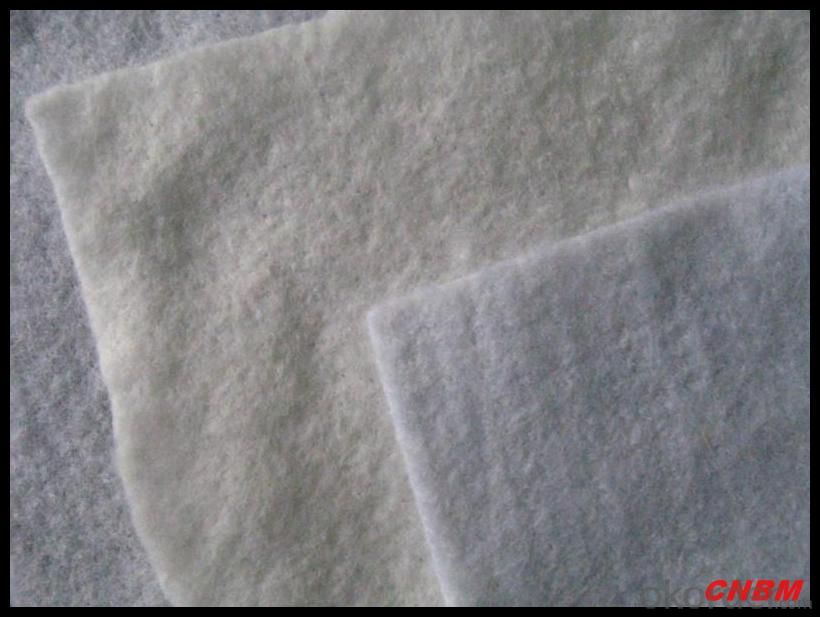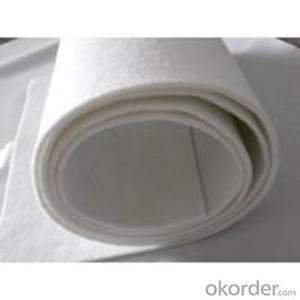Hot Sale Export Polyester Filament Woven&Nonwoven Geotextile
- Loading Port:
- China main port
- Payment Terms:
- TT OR LC
- Min Order Qty:
- 2000 m²
- Supply Capability:
- 500000 m²/month
OKorder Service Pledge
OKorder Financial Service
You Might Also Like
Item specifice
Polyester Continuous Filament Spunbonded non woven geotextile
Geotextiles are permeable nonwoven fabrics used to separate,filter,reinforce, protect or drain.Geotextiles allow filtration or separation of granular layers in roads and rail applications,used to protect membranes in landfill applications,used in coastal defence applications and used in landscaping to protect surfaces and structures from weeds and root growth.
Geotextiles are availabel as woven and non-woven .As liner protection, against physical damage, the non wovens are normally the answer.They are made up of fibers of polyester or polypropylene in random directions and punched together by needles during the manufacturing process.Geotextiles are commenly used to separate layers like clay and drainage and to protect liner from damage.
Detailed Images

Packaging & Shipping
Packing: PLASTIC FILM INSIDE, AND WOVEN BAG OUTSIDE
Shipping: About 15 days after receipt the deposit
pecifications
geotextile fabric
permeability,filtration,easy for construction
ISO and CE certificate
Good quality and competitive price
Our Service
Quality assurance
1.On a regular basis or as per your request,we entrust national testing agencies to conduct quality inspections
2. Strictly in accordance with the ISO9001-2008 international quality system standard,we monitor and manage the whole process throughout production,quality testing,and measurement to ensure product quality
3. For quality-related construction delay or substandard construction(except for damage or losses due to customer’s responsibility or irresistible natural disasters),we have refunding,replacement,and repair services.We will respond to customers’ feedbacks on quality issues within 24 hours.
After-sales service
1.In order to provide customers with comprehensive technical support,we will provide technical and other related information upon request in a timely manner.
2.In required,we will appoint specialized technicians to the construction site to give technical trainings to construction people,and offer technical guidance throughout the whole construction process.
3.For damage due to shipment and delivery,after we receive the complaint,we will check the issure through provided pictures and videos.If our responsibility is confirmed,we wil offer free replacement.
4.When the construction is completed,as your request,our technical staff may participate in the final acceptance.
FAQ:
Q: What kind of payments does jenor support?
A: T/T, L/C, Cash are accepted.
Q: Do you charge for the samples?
A: Accordeing to our company policy, the samples are free, we only charge the freight fee. And we will return the freight fee during the next order.
Q: Can you produce according to customers' design?
A: Sure, we are professional manufacturer, OEM and ODM are both welcome.
Q: Do you have other products?
A: Yes, please check the pictures:
- Q:How do geotextiles contribute to land reclamation in coastal areas?
- Geotextiles contribute to land reclamation in coastal areas by acting as a barrier between the existing soil and the new land area. They help prevent erosion by stabilizing the soil, allowing vegetation to grow, and providing a foundation for the new land. Additionally, geotextiles can filter sediment and contaminants, improving water quality and protecting the surrounding ecosystem.
- Q:What are the different factors to consider for geotextile selection in landfill applications?
- There are several factors to consider when selecting geotextiles for landfill applications. These include the type and composition of waste being disposed of, potential chemical interactions, required strength and durability, permeability and filtration requirements, and compliance with regulatory standards. Other factors such as installation and maintenance costs, availability, and environmental sustainability also play a role in geotextile selection for landfill applications.
- Q:What is geomembrane geomembrane, composite geomembrane
- What is geomembrane geomembrane, composite geomembrane
- Q:How do geotextiles help with separation and stabilization in railroads?
- Geotextiles are used in railroads to provide separation and stabilization. They help by creating a barrier between the different layers of materials used in railroad construction, preventing them from mixing or shifting. This separation ensures proper drainage and prevents the loss of fine particles. Additionally, geotextiles enhance the stability of the railroad by distributing loads more evenly, reducing the potential for settlement or deformation. Overall, geotextiles play a crucial role in maintaining the integrity and longevity of railroads.
- Q:How do geotextiles affect soil properties?
- Geotextiles can have various effects on soil properties. They can enhance soil stability and prevent erosion by acting as a barrier against soil movement and water flow. Geotextiles can also improve soil filtration and drainage by allowing water to pass through while retaining soil particles. Additionally, they can provide reinforcement to the soil, increasing its load-bearing capacity and reducing settlement. Overall, geotextiles can significantly influence soil properties, improving its performance and durability in various geotechnical applications.
- Q:Can geotextiles be used in agricultural waste management systems?
- Yes, geotextiles can be used in agricultural waste management systems. They are often used for soil stabilization, erosion control, and filtration in agricultural applications, including waste management systems. Geotextiles can help to prevent soil erosion, filter out pollutants, and promote water drainage in these systems, making them an effective solution for managing agricultural waste.
- Q:How are geotextiles tested for permeability?
- Geotextiles are tested for permeability through various methods, such as the constant head test, falling head test, and the gradient ratio test. These tests involve measuring the flow of water through the geotextile under controlled conditions to determine its permeability properties.
- Q:What are the key properties of geotextiles?
- Geotextiles have several key properties that make them useful in various applications. These properties include high tensile strength, permeability, durability, and resistance to chemicals and UV radiation. They also offer excellent filtration and separation capabilities, allowing for effective drainage and soil stabilization. Geotextiles are lightweight and easy to handle, making them convenient for installation. Overall, these properties make geotextiles a versatile and reliable solution for erosion control, road construction, and other civil engineering projects.
- Q:How do geotextiles help in soil reinforcement?
- Geotextiles help in soil reinforcement by providing a stable and strong layer between the soil and other materials. They distribute the load evenly, preventing soil erosion and enhancing its strength and stability. Geotextiles also allow water to drain through while retaining soil particles, reducing the risk of soil movement or failure.
- Q:Are geotextiles environmentally friendly?
- Yes, geotextiles can be considered environmentally friendly. They are typically made from synthetic materials such as polyester or polypropylene, which are non-biodegradable. However, geotextiles offer various environmental benefits such as erosion control, soil stabilization, and water filtration. They help prevent soil erosion, reduce sedimentation in water bodies, and improve overall water quality. Additionally, geotextiles can be recycled and reused, further minimizing their environmental impact.
1. Manufacturer Overview |
|
|---|---|
| Location | |
| Year Established | |
| Annual Output Value | |
| Main Markets | |
| Company Certifications | |
2. Manufacturer Certificates |
|
|---|---|
| a) Certification Name | |
| Range | |
| Reference | |
| Validity Period | |
3. Manufacturer Capability |
|
|---|---|
| a)Trade Capacity | |
| Nearest Port | |
| Export Percentage | |
| No.of Employees in Trade Department | |
| Language Spoken: | |
| b)Factory Information | |
| Factory Size: | |
| No. of Production Lines | |
| Contract Manufacturing | |
| Product Price Range | |
Send your message to us
Hot Sale Export Polyester Filament Woven&Nonwoven Geotextile
- Loading Port:
- China main port
- Payment Terms:
- TT OR LC
- Min Order Qty:
- 2000 m²
- Supply Capability:
- 500000 m²/month
OKorder Service Pledge
OKorder Financial Service
Similar products
New products
Hot products
Related keywords































